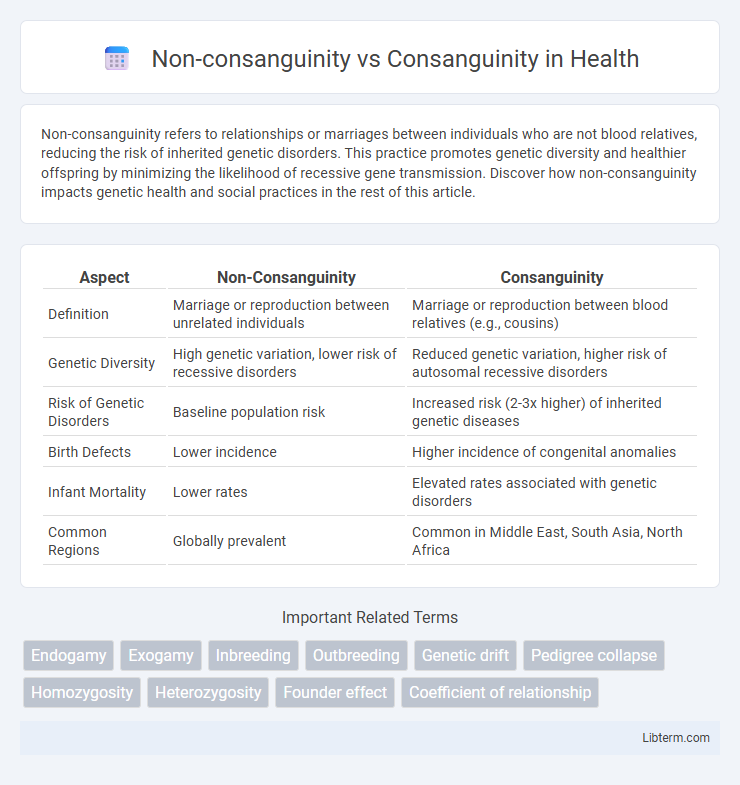Non-consanguinity refers to relationships or marriages between individuals who are not blood relatives, reducing the risk of inherited genetic disorders. This practice promotes genetic diversity and healthier offspring by minimizing the likelihood of recessive gene transmission. Discover how non-consanguinity impacts genetic health and social practices in the rest of this article.
Table of Comparison
| Aspect | Non-Consanguinity | Consanguinity |
|---|---|---|
| Definition | Marriage or reproduction between unrelated individuals | Marriage or reproduction between blood relatives (e.g., cousins) |
| Genetic Diversity | High genetic variation, lower risk of recessive disorders | Reduced genetic variation, higher risk of autosomal recessive disorders |
| Risk of Genetic Disorders | Baseline population risk | Increased risk (2-3x higher) of inherited genetic diseases |
| Birth Defects | Lower incidence | Higher incidence of congenital anomalies |
| Infant Mortality | Lower rates | Elevated rates associated with genetic disorders |
| Common Regions | Globally prevalent | Common in Middle East, South Asia, North Africa |
Definition of Consanguinity and Non-Consanguinity
Consanguinity refers to the genetic relationship between individuals who share a common ancestor, typically measured by the degree of relatedness or blood relation, such as first cousins or siblings. Non-consanguinity describes relationships or unions between individuals who lack any significant genetic connection or shared ancestry, leading to no increased risk of inheriting genetic disorders linked to consanguineous mating. Understanding consanguinity is essential in genetic counseling and population studies due to its impact on the prevalence of autosomal recessive diseases and hereditary conditions.
Types and Degrees of Consanguineous Relationships
Consanguinity refers to the genetic relationship between individuals who share a common ancestor, categorized by degrees based on the closeness of blood ties, such as first-degree (parent-child, siblings), second-degree (grandparent-grandchild, uncle-niece), and third-degree relatives (first cousins). Non-consanguinity denotes relationships without shared bloodlines, often through marriage or adoption, lacking genetic commonality that defines consanguineous connections. Understanding these types and degrees is essential for genetic counseling, inheritance pattern analysis, and risk assessment of recessive genetic disorders.
Prevalence of Consanguinity Worldwide
Consanguinity, defined as the union between individuals who are closely related, exhibits varying prevalence globally, with rates exceeding 50% in parts of the Middle East, North Africa, and South Asia. In contrast, non-consanguineous marriages, where partners are unrelated, dominate in Western countries and many urban areas worldwide. Understanding the distribution of consanguinity is essential for genetic counseling and public health strategies due to its association with increased risk of autosomal recessive disorders.
Genetic Implications of Consanguinity
Consanguinity refers to the union between individuals who share a common ancestor, increasing the probability of homozygosity for recessive genetic disorders due to inheriting identical alleles from both parents. This elevated risk results in higher incidences of autosomal recessive conditions and congenital anomalies compared to non-consanguineous unions, where genetic diversity reduces such risks. Population studies demonstrate that consanguineous marriages significantly impact allele frequencies and genetic health burdens in communities practicing them.
Health Risks Associated with Consanguineous Marriages
Consanguineous marriages, typically between relatives like first cousins, significantly increase the risk of autosomal recessive genetic disorders due to shared inherited mutations. This practice is linked to higher incidences of congenital anomalies, neonatal mortality, and genetic diseases such as thalassemia and cystic fibrosis in offspring. In contrast, non-consanguineous marriages reduce the probability of inheriting identical deleterious alleles, thereby lowering the overall risk of genetic health complications.
Advantages of Non-Consanguineous Unions
Non-consanguineous unions significantly reduce the risk of genetic disorders by minimizing the inheritance of recessive genes, promoting healthier offspring. These unions enhance genetic diversity, which contributes to stronger immune systems and greater adaptability to environmental changes. Furthermore, non-consanguineous relationships often result in decreased rates of congenital anomalies and hereditary diseases compared to consanguineous marriages.
Cultural and Social Influences on Marriage Choices
Non-consanguinity and consanguinity significantly shape marriage choices through cultural and social norms that vary globally, with consanguineous marriages often favored in communities emphasizing lineage preservation and familial alliances. These practices influence social cohesion, inheritance patterns, and genetic counseling due to varying acceptance of cousin marriages in societies such as those in the Middle East versus Western countries. Understanding these influences is crucial for public health policies and social integration efforts in multicultural environments.
Legal and Religious Perspectives on Consanguinity
Legal perspectives on consanguinity vary widely, with many jurisdictions imposing marriage restrictions to prevent unions between close blood relatives due to genetic health risks and social norms. Religious doctrines often have specific guidelines on consanguineous marriages, with some faiths permitting unions between certain degree relatives while others strictly prohibit them to uphold moral and spiritual principles. The intersection of legal and religious views shapes policies and cultural practices surrounding consanguinity, influencing marriage laws, inheritance rights, and community standards globally.
Strategies for Genetic Counseling and Risk Reduction
Genetic counseling strategies for non-consanguineous couples typically emphasize carrier screening for common recessive disorders based on ethnic background and family history, while consanguineous couples require more comprehensive genomic analysis due to increased risk of autosomal recessive conditions. Risk reduction approaches in consanguinity often involve preconception genetic testing, detailed pedigree analysis, and consideration of assisted reproductive technologies like preimplantation genetic diagnosis (PGD) to minimize inherited disease transmission. Personalized counseling that integrates molecular diagnostics with cultural sensitivity is critical for effective risk assessment and informed reproductive decision-making in both populations.
Future Trends and Research in Consanguinity Studies
Future trends in consanguinity research emphasize genetic risk assessment advancements and the integration of genomic technologies to identify hereditary disease patterns in populations practicing consanguineous marriages. Emerging studies focus on the long-term health impacts, including autosomal recessive disorder prevalence, while exploring sociocultural factors influencing consanguineous unions. Improved bioinformatics tools and population-wide genetic screening promise enhanced counseling strategies and targeted interventions to mitigate genetic risks associated with consanguinity.
Non-consanguinity Infographic

 libterm.com
libterm.com